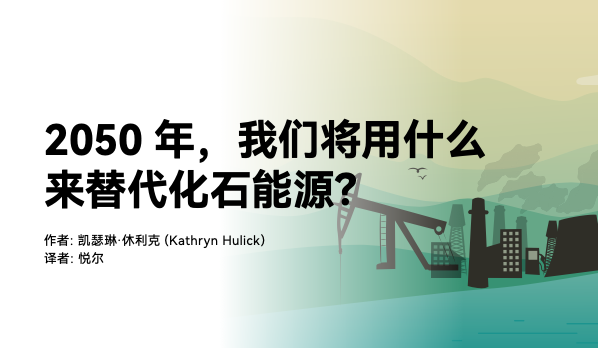This article appears in the July 2022 issue of Front Vision, an educational Chinese-language magazine for kids. It is reproduced here with permission.

Welcome to the year 2050. In cities around the world, cars whiz past tall buildings and factories, yet the air is clear, clean, and cool. People have stopped burning coal, oil, and gas to run engines or make heat and electricity. These fossil fuels no longer spew pollution and greenhouse gases into the air. As a result, climate change is slowing. Dangerous wildfires, hurricanes, and other natural disasters are becoming less common. Humanity has managed to back the world away from the brink of disaster.
How are we making energy without fossil fuels? Some of the answers are in plain sight. Solar panels glint on nearly every roof, catching the energy of the sun. Wind turbines rise like tall trees from hills and seas, capturing the blowing wind. Large dams tame the power of rushing rivers. Along roads and in garages, electric vehicles plug in to recharge. Other answers are less obvious. Technology has made machines, buildings, and power systems more efficient. So people are doing more with less energy.
Many experts have tried to predict what a world without fossil fuels might look like and how we might get there. One of those experts is Jim Williams, a professor of Energy Systems Management at the University of San Francisco. He says, “The goal of my work is to chart out a set of actions that humans need to engage in in order to have the energy that we need to fuel our busy lives and our production of the things that we use in our lives without causing damage to the living earth.”
In a 2021 study, he and his colleagues looked at eight different ways the United States could reach net zero emissions by 2050. Net zero means that any carbon dioxide emissions get taken out of the atmosphere by plants or by carbon capture technology. He found that it is entirely possible to succeed in reaching this goal. “Not only did it look technically feasible to reach net zero, but the cost wasn’t that high,” he says.
Let’s take a tour around the energy sources of the future. We’ll visit an imagined version of 2050 in which fossil fuels are a distant memory.
Solar Power
Our first stop is the Sahara desert in Africa. In 2050, the scorching hot sand dunes are home to more than just birds, camels, and other desert wildlife. In numerous locations in and around the desert, circular arrangements of many thousands of mirrors glint in the sunlight. These are concentrated solar power (CSP) plants. In each one, the mirrors are arranged in concentric circles around a central tower. The mirrors move throughout the day, following the sun as it travels across the sky. No matter what direction the sunlight comes form, these mirrors reflect it towards the tower, which use the resulting heat to generate electricity from conventional steam-driven turbines.
The Sahara is already home to a CSP plant called the Noor Ouarzazate Solar Complex, or just Noor for short. (The word “noor” means “light” in Arabic). It is located outside of Ouarzazate, Morocco, at the edge of the Sahara desert. It produces up to 500 GW·h per year. In the future, even larger CSP plants will be able to produce substantial amounts of electricity.
In addition to concentrating solar power, we can also use solar energy for photovoltaic (PV) power generation. Photovoltaics is the conversion of light into electricity using semiconducting materials that exhibit the photovoltaic effect. And that’s how our typical solar panel uses the sun’s energy.
Hot deserts have the most potential when it comes to capturing lots of sunlight. However, it doesn’t make sense to build huge solar power plants only in deserts and then try to distribute that power far away. “It’s not worth it,” says Williams. “You can build solar wherever you are.” Even cold regions such as Northern Europe and the Northern United States can make good use of solar panels and solar farms, which are large arrays of solar panels that function like a power plant.
The solar panels of 2050 will also work better than the ones today, meaning that a panel of the same size and in the same location will be able to capture more energy. This will be possible because engineers are discovering new materials and new methods of construction for solar cells, the sunlight- capturing units that make up a panel. Most solar cells today are made of silicon. Thin-film solar cells made from a family of crystals called perovskites do an even better job than silicon. Layering different thin materials one on top of another also helps capture more sunlight.
Wind Power
Wind is another resource available all around the world. In 2050, wind turbines will be a common sight. They work best in very windy places, such as open plains, gaps between mountains, and bare hilltops. But the best place for wind turbines is out over open water.
The next stop on our tour is the North Sea, which borders the UK, northern Europe, and Scandinavia. In 2050, this sea is home to thousands of massive wind turbines. In shallow seas, every turbine may rise from platform that extends all the way to a foundation anchored to the sea floor. In deeper areas, turbines float on the waves, tethered to the bottom with mooring lines made of chains or steel cables. Undersea cables carry electricity from the turbines to an offshore electrical substation. From there, another undersea cable transmits the electricity to the electrical grid on land.
In 2022, dozens of offshore wind farms already exist in the North Sea. They are all small, though, producing at most several hundred MW of power. However, off the Yorkshire Coast of the UK, construction is just getting started on what will be the largest offshore wind farm in the world, with 3,600 MW capacity. It’s named Dogger Bank Wind Farm. When complete, it will have 600 floating turbines, each 260 meters (853 ft) high. That’s almost as tall as the Eiffel towe.
The UK, which is an island nation with lots of windy oceans all around, plans to power every home in the country with wind by 2030. Eighteen nations with windy coasts, including China, Japan, most of Europe, and the United States, already have offshore windfarms and are building new ones. Another 17 countries, including India, Australia, Brazil, and Saudi Arabia plan to have offshore wind farms by 2030.
The wind turbines themselves may look different by 2050. Engineers have proposed numerous different shapes and materials for turbines. Some have no blades – one of those is a tall pole that produces energy by vibrating in the wind. It remains to be seen whether any of these innovative ideas will ever outperform the standard blade shapes. Slightly flexible turbine blades inspired by insect wings may do a better job adapting to different wind directions and speeds.
A World Powered by Sun and Wind
Most experts agree that the sun and the wind will be the most important and most common non-fossil-fuel sources of energy in the future. That’s mainly because they’ve gotten so cheap. And that means that most countries will be able to afford to build new solar and wind infrastructure. “If fossil fuels are off the table, then the lowest cost sources of energy are wind and solar,” says Williams. They are wonderful sources of energy because they never run out and do not emit anything that could worsen climate change or pollute the environment. Also, countries can make their own solar and wind energy. They don’t need to buy fuels from other nations.
However, these energy sources do have some serious drawbacks. They take up a lot of space on land and in the ocean. This land use can harm ecosystems. It can also cause social justice issues if local people don’t agree that a certain patch of land or sea should be used for power generation. However, these harms are arguably much less impactful than the harm to both ecosystems and people from climate change.
The biggest problem with both solar and wind energy is that they are intermittent. Wind turbines don’t spin in very calm weather. Solar panels don’t make energy at night or on very cloudy days. They also make less energy in the winter than in the summer. Batteries can help store some solar and wind energy for later, but so far they are only reliable at moving energy over the course of a day, explains Williams. “They are not good for moving energy over the course of a month or a season,” he says. “That’s why we have to keep thermal generation around.”
Thermal generation means burning fuels to make energy. In most of the net-zero scenarios that Williams looked at in his 2021 study, coal-fired power plants are completely gone, but the US is still burning some natural gas and petroleum for energy in 2050. Carbon capture technology could offset these emissions. However, in one scenario, Williams and his team didn’t allow any fossil fuels to remain. They found it was still possible to reach net zero – but it would cost more. For thermal generation, this scenario relies mainly on biomass.
Biomass typically means burning plant matter or other organic materials to make energy. Though this burning does emit pollution and greenhouse gases, generating new biomass usually means growing lots of plants that take carbon dioxide out of the air. Also, biomass can come from crop waste or tree waste that currently rots and releases harmful emissions anyway.
Energy from the Earth and Water
Our tour of the world in 2050 isn’t over yet. Solar and wind may be the most important sources of clean energy in the future, but the world needs all the solutions it can get. Many other energy sources will help the world reach net zero emissions. Many of them are also more reliable than solar and wind, so can help back up these power sources.
Our next stop is Indonesia. In 2050, this country is getting a huge amount of energy from deep inside the Earth. The island nation sits over the Pacific Ring of Fire, an area filled with volcanoes where the earth regularly rumbles and shakes, generating lots of heat near the surface. Geothermal power plants harness this heat and use it directly or turn it into electricity.
As of 2022, the United States leads the world in geothermal energy production, mainly thanks to the Geysers Geothermal Complex(a complex of 3 geothermal power stations) in California, which has a capacity of 1,205 MW. Indonesia is rapidly catching up, though. It’s home to 40% of the entire world’s geothermal energy potential. By 2030, the country plans to have the capacity to produce 8,000 MW of geothermal energy. Any area that is geologically active can produce geothermal power. The Philippines, Turkey, and New Zealand all have over 1,000 MW of geothermal energy potential already. Unfortunately, this source of energy is very limited. Experts have estimated that even if the world tapped every available geothermal resource, this would only produce about 80,000 MW.
Over in China in 2050, numerous dams span many mighty rivers. China has more hydropower potential than any other in the world, up to 600,000 MW. As of 2022, China had already tapped into 340,000 MW of hydropower capacity. Its gigantic Baihetan hydropower plant, located on Jinsha river, an upstream branch of the famous Yangtze river, is almost complete. It is the largest dam under construction globally, the highest comprehensive technical difficulty of the giant hydropower station . By the end of 2022, it will have a capacity of 16,000 MW. Brazil, the United States, Russia, Canada, and India all generate a lot of hydropower already and can add more in the future.
Hydropower has some problems, though. Building a large dam floods land and disrupts water systems. Ecosystems often suffer as a result. So some companies are finding ways to make hydropower from turbines installed in fast-moving rivers – no dam required. Others hope to harness the energy of ocean waves or currents.
Splitting and Fusing Atoms
Next, we head to Jaitapur in Maharashtra, India in 2050, to see the world’s largest nuclear power plant. It contains six European pressurized water reactors. They split apart atoms of radioactive fuel, releasing a huge amount of energy – up to 9,900 MW. These nuclear reactions do not produce any greenhouse gas emissions. New reactors like these are much safer than the ones inside early nuclear power plants. They also produce much less radioactive waste.
As of 2022, India is planning to reach net-zero by 2070. The country’s plans include all types of clean energy, including numerous new nuclear power plants. Several other countries, especially in Asia, have plans to develop more nuclear power capacity. However, nuclear energy is very expensive and also controversial. In Williams’ scenarios, nuclear played a very small role in helping the US reach net zero. That’s because he was looking for the most cost-effective way to get there. In a scenario that tried to reach net zero without claiming a ton of land for wind and solar, nuclear played a larger role.
Engineers are working on ways to build smaller, cheaper nuclear power plants. They have also found ways to improve old plants to make them safer and allow them to run on more efficient fules that don’t produce as much radioactive waste. These types of improvements could change the picture and make nuclear a more important part of the clean energy future.
The final stop on our tour of the world in 2050 is something truly futuristic. In the United States, we find the world’s first fusion power plant. It contains massive magnets that force very hot plasma into a swirling shape. As the plasma swirls, atoms crash together and fuse, releasing huge amounts of nuclear energy. The fuel for fusion comes from seawater. There is no risk of meltdown and there are no harmful emissions, either.
As of 2022, there are no working fusion power plants. It will take a lot more time and money to get the technology to the point where it could add electricity to the grid. However, scientists who work on it are optimistic. Many think that having a working future power plant by 2050 is an achievable goal. Arturo Dominguez works on fusion energy at the Princeton Plasma Physics Laboratory. He says, “We have, as a community, agreed on the goal of developing a fusion pilot plant by the 2040s and mapped out the big gaps that need to be worked on and solved to get there.”
A Road Map to the Future
All of the places we visited on our tour mainly produce electricity. However, people also burn fossil fuels to power transportation and industrial processes. To reach net zero or a fossil-fuel-free future, we will need to produce green fuels. We will also need to use less energy and use it more efficiently. Finally, we’ll have to electrify everything that we can. “Using electricity to eliminate burning of fuels wherever you can is a really important part of decarbonization,” says Williams.
In the world of 2050 that we have been imagining, homes and buildings will be heated and cooled with electric heat pumps. Electric cars will be the only ones on the road. Both of these technologies already exist. One bonus is that electric cars are much more efficient than gas-powered cars. So transportation will likely require less energy in 2050 than it does now. New, green fuels will have to be found for aircraft, ships, trucks, and industrial processes. Hydrogen has a lot of potential to replace these fuels. It’s easy to make hydrogen from water using electricity.
Can we make this world of 2050 a reality? Jim Williams knows we can. And we don’t need to make any drastic changes. “As long as we are intent and steady in making this happen, then we don’t have to junk our car. We don’t have to tear down our house,” he says. “We just have to do the right thing when the time comes to replace what we’ve already got.” That means only building new vehicles, homes, buildings, factories, and power plants that run on clean energy.

